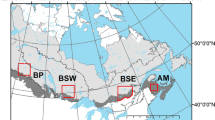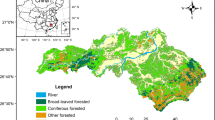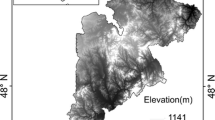Abstract
Context
Understanding the range of possible climate change impacts on forests and the interactions between them is vital to sustainable forest management.
Aims
We examine whether the combined influence of climate change and timber harvest will affect tree species distribution and productivity beyond predictions based on climate alone.
Methods
We used the landscape disturbance model LANDIS-II to simulate two climate and two harvest scenarios in 14,000 ha of managed watersheds.
Results
The elevated temperature led to a decline in the abundance of boreal species and a substantial increase in some temperate and pioneer species. Importantly, the interaction of climate change and timber harvest yielded changes in the distribution of some species that would not be expected based on climate alone. Conversely, some late-successional species exhibited resistance to climate-driven changes in their distribution. Climate change caused an increase in forest productivity when harvest was simulated, but a decrease in no-harvest scenarios. A time lag in forest response was likely responsible for this decrease in the absence of widespread mortality.
Conclusions
The finding that disturbance may drive the range expansion of early-successional broadleaved species and cause a decline of red spruce has implications for forest community associations, as well as for forest management where conifers are favoured for pulp production.






Similar content being viewed by others
References
Aber JD, Federer CA (1992) A generalized, lumped-parameter model of photosynthesis, evapotranspiration and net primary production in temperate and boreal forest ecosystems. Oecologia 92:463–474. doi:10.1007/BF00317837
Aber JD, Ollinger SV, Driscoll CT (1997) Modelling nitrogen saturation in forest ecosystems in response to land use and atmospheric deposition. Ecol Model 101:61–78. doi:10.1016/S0304-3800(97)01953-4
Aber JD, Neilson RP, McNulty S, Lenihan JM, Bachelet D, Drapek RJ (2001) Forest processes and global environmental change: predicting the effects of individual and multiple stressors. Bioscience 51:735–751. doi:10.1641/0006-3568(2001)051[0735:FPAGEC]2.0.CO;2
Aitken SN, Yeaman S, Holliday JA, Wang T, Curtis-McLane S (2008) Adaptation, migration, or extirpation: climate change outcomes for tree populations. Evol Appl 1:95–111. doi:10.1111/j.1752-4571.2007.00013.x
Bourque CPA, Hassan QK, Swift DE (2010) Modelled potential species distribution for current and projected future climates for the Acadian Forest Region of Nova Scotia. Nova Scotia Department of Natural Resources. http://www.gov.ns.ca/natr/forestry/reports/Final-Report-for-NS-Cliamte-Change-Project.pdf. Accessed 09 Mar 2011
Burns RM, Honkala BH (1990) Silvics of North America: 1. Conifers; 2. Hardwoods. USDA Forest Service, Washington, DC
Canadian Centre for Climate Modelling and Analysis (2009) CRCM 4.2.3. data. Environment Canada. http://www.cccma.bc.ec.gc.ca. Accessed 09 Mar 2011
Dale VH, Joyce LA, McNulty M, Neilson RP, Ayres MP, Flannigan MD, Hanson PJ, Irland LC, Lugo AE, Peterson CJ, Simberloff D, Swanson FJ, Stocks BJ, Wotton BM (2001) Climate change and forest disturbances. Bioscience 51:723–734. doi:10.1641/0006-3568(2001)051[0723:CCAFD]2.0.CO;2
Goodale CL, Aber JD, Farrell EP (1998) Predicting the relative sensitivity of forest production in Ireland to site quality and climate change. Clim Res 10:51–67. doi:10.3354/cr010051
Gustafson EJ, Shvidenko AZ, Sturtevant BR, Scheller RM (2010) Predicting global change effects on forest biomass and composition in south-central Siberia. Ecol Appl 20:700–715. doi:10.1890/08-1693.1
He HS, Mladenoff DJ, Crow TR (1999) Linking an ecosystem process model and a landscape model to study forest species response to climate warming. Ecol Model 114:213–233. doi:10.1016/S0304-3800(98)00147-1
Intergovernmental Panel on Climate Change (2007) In: Solomon S, Qin D, Manning M, Chen Z, Marquis M, Averyt KB, Tignor M, Miller HL (eds) Climate change 2007: The physical science basis. Contribution of Working Group I to the Fourth Assessment Report of the IPCC. Cambridge University Press, Cambridge
Keys K, Neily PD, Quigley EJ, Stewart BJ (2003) Forest ecosystem classification of Nova Scotia’s model forest. Nova Forest Alliance, Stewiacke
Körner C, Asshoff R, Bignucolo O, Hättenschwiler S, Keel SG, Peláez-Riedl S, Pepin S, Siegwolf RTW, Zotz G (2005) Carbon flux and growth in mature deciduous forest trees exposed to elevated CO2. Science 309:1360–1362. doi:10.1126/science.1113977
Kuparinen A, Savolainen O, Schurr FM (2010) Increased mortality can promote evolutionary adaptation of forest trees to climate change. For Ecol Manage 259:1003–1008. doi:10.1016/j.foreco.2009.12.006
Landhäusser SM, Deshaies D, Lieffers VJ (2010) Disturbance facilitates rapid range expansion of aspen into higher elevations of the Rocky Mountains under a warming climate. J Biogeogr 37:68–76. doi:10.1111/j.1365-2699.2009.02182.x
Lo YH, Blanco JA, Kimmins JP (2010) A word of caution when planning forest management using projections of tree species range shifts. For Chron 86:312–316. doi:10.5558/tfc86312-3
Loo JA, Ives N (2003) The Acadian forest: historical condition and human impacts. For Chron 79:462–474. doi:10.5558/tfc79462-3
Magasi LP (1995) Forest insect pests in the Maritimes region. In: Armstrong JA, Ives WGH (eds) Forest insect pests in Canada. NRC Research Press, Ottawa
McKenney DW, Pedlar JH, Lawrence K, Campbell K, Hutchinson MF (2007) Potential impacts of climate change on the distribution of North American trees. Bioscience 57:939–948. doi:10.1641/B571106
McMahon SM, Parker GG, Miller DR (2010) Evidence for a recent increase in forest growth. Proc Natl Acad Sci 107:3611–3615. doi:10.1073/pnas.0912376107
Millar CI, Stephenson NL, Stephens SL (2007) Climate change and forests of the future: managing in the face of uncertainty. Ecol Appl 17:2145–2151. doi:10.1890/06-1715.1
Mosseler A, Lynds JA, Major JE (2003) Old-growth forests of the Acadian Forest Region. Environ Rev 11:47–77. doi:10.1139/a03-015
Neily PD, Quigley EJ, Benjamin L, Stewart BJ, Duke T (2003) Ecological land classification for Nova Scotia. Nova Scotia Department of Natural Resources, Truro
Nova Scotia Department of Natural Resources (2010) Forest inventory—geographic information systems. http://www.gov.ns.ca/natr/forestry/gis/dl_forestry.asp. Accessed 10 Mar 2011
Rastetter EB (1996) Validating models of ecosystem response to climate change. Bioscience 46:190–198
Ravenscroft C, Scheller RM, Mladenoff DJ, White MA (2010) Forest restoration in a mixed-ownership landscape under climate change. Ecol Appl 20:327–346. doi:10.1890/08-1698.1
Scheller RM, Mladenoff DJ (2005) A spatially interactive simulation of climate change, harvesting, wind, and tree species migration and projected changes to forest composition and biomass in northern Wisconsin, USA. Glob Change Biol 11:307–321. doi:10.1111/j.1365-2486.2005.00906.x
Scheller RM, Mladenoff DJ (2008) Simulated effects of climate change, fragmentation, and inter-specific competition on tree species migration in northern Wisconsin, USA. Clim Res 36:191–202. doi:10.3354/cr00745
Scheller RM, Domingo JB, Sturtevant BR, Williams JS, Rudy A, Gustafson EJ, Mladenoff DJ (2007) Design, development, and application of LANDIS-II, a spatial landscape simulation model with flexible temporal and spatial resolution. Ecol Model 201:409–419. doi:10.1016/j.ecolmodel.2006.10.009
Seymour RS, White AS, deMaynadier PG (2002) Natural disturbance regimes in northeastern North America—evaluating silvicultural systems using natural scales and frequencies. For Ecol Manage 155:357–367. doi:10.1016/S0378-1127(01)00572-2
Steenberg JWN, Duinker PN, Bush PG (2011) Exploring adaptation to climate change in the forests of central Nova Scotia, Canada. For Ecol Manage 262:2316–2327. doi:10.1016/j.foreco.2011.08.027
Townsend P (2004) Nova Scotia forest inventory based on permanent sample plots measured between 1993 and 2003. Nova Scotia Department of Natural Resources, Truro
Vanclay JK, Skovsgaard JP (1997) Evaluating forest growth models. Ecol Model 98:1–12. doi:10.1016/S0304-3800(96)01932-1
Xu C, Gertner GZ, Scheller RM (2009) Uncertainties in the response of a forest landscape to global climate change. Glob Change Biol 15:116–131. doi:10.1111/j.1365-2486.2008.01705.x
Acknowledgments
We are thankful to Laird Van Damme and Arnold Rudy with KBM Forestry Consultants Inc., Robert Scheller at Portland State University, Barry Geddes with Halifax Water, the School for Resource and Environmental Studies and GIS Centre—Dalhousie University, and the Nova Scotia Department of Natural Resources.
Funding
This project was funded by the Natural Sciences and Engineering Research Council of Canada (NSERC) and Halifax Water.
Author information
Authors and Affiliations
Corresponding author
Additional information
Handling Editor: Matthias Dobbertin
Contribution of the co-authors
James Steenberg was responsible for the experimental design, running the data analysis, and writing the paper. Peter Duinker and Peter Bush were responsible for supervising the work and providing input and manuscript revisions.
Rights and permissions
About this article
Cite this article
Steenberg, J.W.N., Duinker, P.N. & Bush, P.G. Modelling the effects of climate change and timber harvest on the forests of central Nova Scotia, Canada. Annals of Forest Science 70, 61–73 (2013). https://doi.org/10.1007/s13595-012-0235-y
Received:
Accepted:
Published:
Issue Date:
DOI: https://doi.org/10.1007/s13595-012-0235-y




